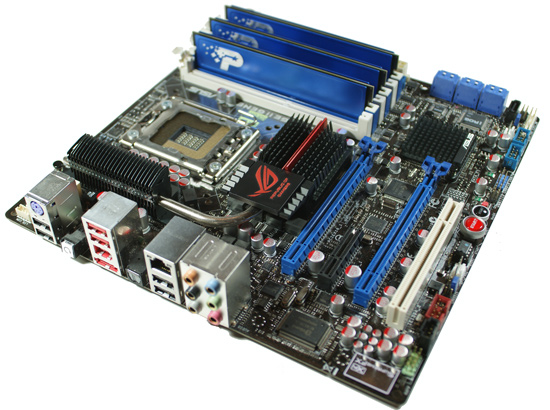Memory Scaling on Core i7 - Is DDR3-1066 Really the Best Choice?
by Gary Key on June 24, 2009 9:00 AM EST- Posted in
- Memory
The Test

We decided to build an i7 uATX system for testing today. We certainly had our pick of various components for a memory test bed with the EVGA Classified, Gigabyte X58 Extreme, and DFI UT X58 boards coming to mind along with higher end video card and storage selections. In the end, we decided taking a practical approach to the component selection would serve us better in showing memory results on a system considered mid-range in the i7 world from a performance viewpoint. We will follow up shortly to see what differences occur in memory performance when utilizing an SSD, different memory/board timings, and additional benchmarks with Virtualization routines.
We settled on the ASUS Rampage II GENE as our motherboard choice based on the available feature set and BIOS options. You could certainly cost reduce this system and utilize the excellent MSI X58M motherboard. Our processor choice was easy as the Core i7 920 is the best selling i7 product and represents what most users currently pair with an X58 board.
We selected the ASUS ENGTX260 video card for GPU duties. It is a non-reference design that offers improved thermals and acoustics over the standard NVIDIA GTX 260 216 designs. The WD Caviar Black 640GB is our hard drive of choice for primary storage purposes with the WD Caviar Green 2TB drive as a logical choice for backup duty. LG’s GGC-H20L Blu-ray playback capable drives fills in for optical duties.
We purchased several 6GB kits for memory duties. We set the BIOS to the advertised settings for each kit on the primary timings and left the sub-timings on auto in the BIOS. Of course, those who like to play around in the BIOS could certainly improve upon our synthetic results but overall, we found very little if any differences in actual applications when tuning the sub-timings.
We chose the Scythe SHURIKEN Rev B CPU Cooler for air-cooling duties. This cooler features a low profile design with quiet operation and good cooling characteristics, which is perfect for a base SFF setup. For the more performance oriented crowd we highly suggest the Thermalright AXP-140 with a Thermaltake 140mm fan. We are currently testing this combination for a uATX shootout and it works well.
Our standard power supply is the excellent SeaSonic M12 SS700HM 700W modular unit. This power supply also works for SLI/CF testing since it supports the necessary PCIe connectors. LIN LI’s PC-V351B turned out to be an excellent choice for this setup although our loaded system was cramped for space. We had to complete some creative engineering for all the cooling systems to work properly while taming cable management obstacles. We utilized the ASUS VH242H 23.6" 1920x1080 LCD monitor for display duties. Finally, we have dropped Vista 64-bit and moved to Windows 7 Ultimate 64-bit for our testing today - it just works better.

Our software choices represent a wide variety of applications and we selected 64-bit versions of the program where applicable to ensure full access to our 6GB memory configuration. Unless otherwise noted, we run each benchmark three times and average the results for our score. We clear the prefetch folder between each test run, defrag, and then reboot when switching to a new benchmark. Our programs are updated to the latest release from the supplier. Turbo mode along with HT is enabled on the Core i7 920 and power management is set to balanced for testing.










47 Comments
View All Comments
darklight0tr - Wednesday, June 24, 2009 - link
You kinda lost me at the Windows 7 admission. Why use an unreleased OS that most of us don't have access to?Gary Key - Wednesday, June 24, 2009 - link
I debated about using Win7, but we have some interesting virtualization benches coming in a couple of weeks with XP mode running on it, both for these tests and looking at 12GB and 24GB loads.Also, memory management and several other performance metrics are just better under Win7 than Vista. I ran most of these tests under Vista 64 and the results (percentage wise) were the same as Win7. I also tried the latest RC version of Win7 (7232), no differences in performance. Not that I expected any as the core code for Win7 has been done for a while but it was to double check. I did not use 7232 since it is not "officially" available for the public. ;)
crimson117 - Wednesday, June 24, 2009 - link
http://www.microsoft.com/windows/windows-7/downloa...">http://www.microsoft.com/windows/windows-7/downloa...There, now everyone here has access to it.
darklight0tr - Wednesday, June 24, 2009 - link
LOL. You got me there, my brain hadn't arrived at work yet when I posted that comment.Still, I don't see the point of replacing the released, established OS with an unreleased one. Testing on both would have made more sense if you wanted to do it that way.
philosofa - Wednesday, June 24, 2009 - link
I lol'd :) Nicely done.Re the article itself; fantastic and thorough work as always! Great to see the debate and various titbits of benching replaced by such a systematic multi-app examination of i7 memory speed & latency effects. Also, cheers for the analysis of min frame rates - this is something that's been on-and-off for a while now, and I, like a lot of others, agree that it's as least as important as average FPS.
Cheers Gary.
Matt Campbell - Wednesday, June 24, 2009 - link
Great job as always Gary, fantastic detail.aileen - Friday, July 3, 2009 - link
Thanks for writing this. It was very helpful. Keep writing.http://www.freshsmileclinic.co.uk/dental-implants-...">http://www.freshsmileclinic.co.uk/dental-implants-...
http://www.freshsmileclinic.co.uk/dental-implant-d...">http://www.freshsmileclinic.co.uk/dental-implant-d...